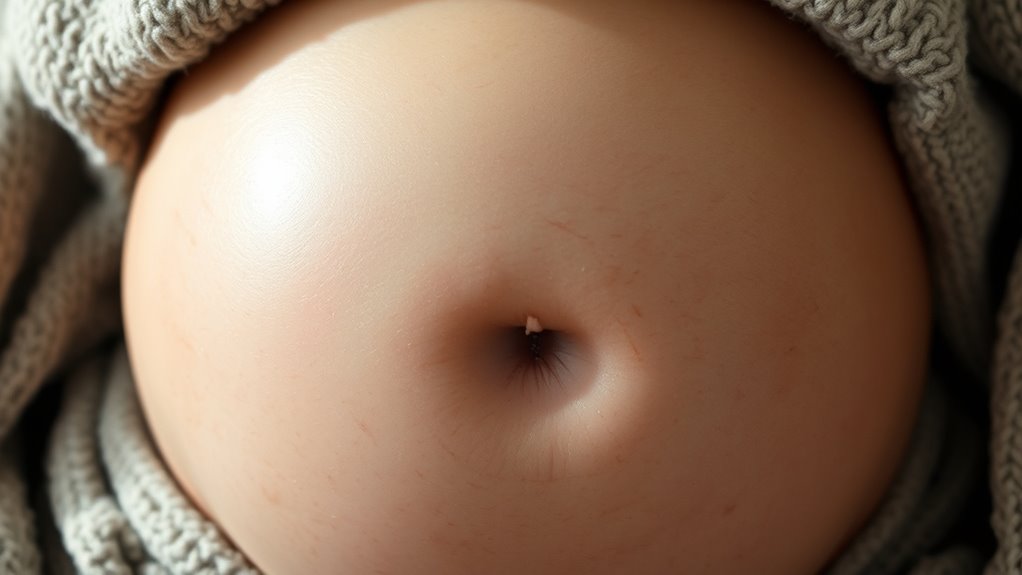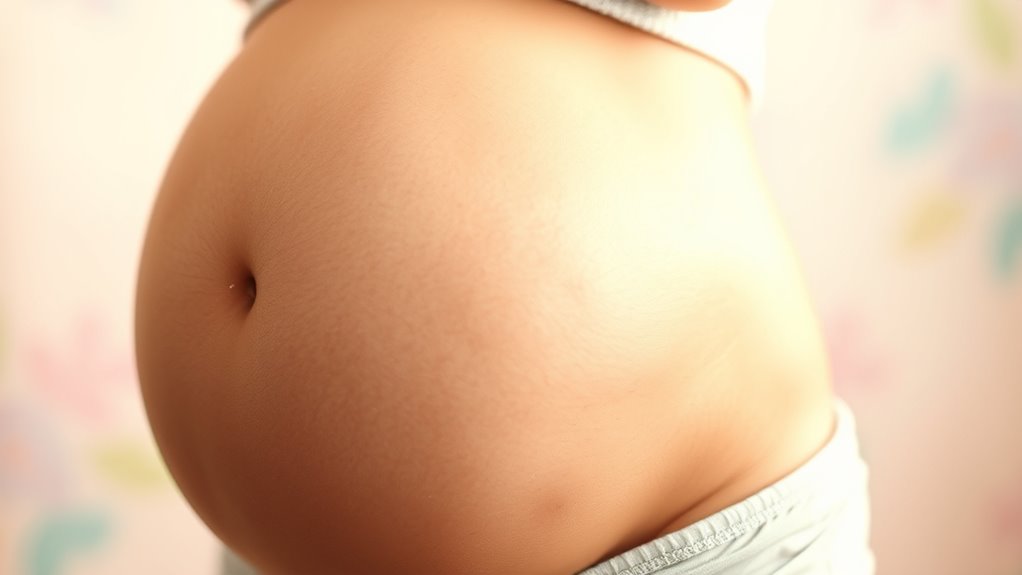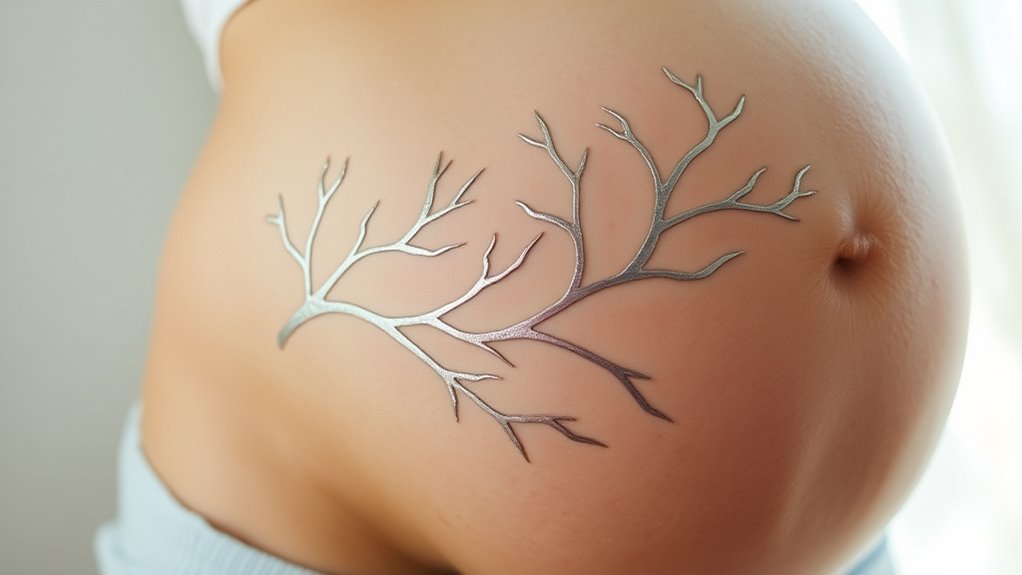Shocking as it might seem, about 80% of pregnant women develop stretch marks due to rapid skin stretching and hormonal changes. They often appear on your tummy, thighs, and breasts, looking pink, red, or brown. Factors like genetics and weight gain can increase your odds, especially in the later months. While you can't completely prevent them, proper hydration and skincare can help. Curious about treating and embracing these changes? There's much more to explore on this journey!
Key Takeaways
- Approximately 80% of pregnant women develop stretch marks, often appearing on the tummy, thighs, and breasts in various colors.
- Hormonal changes, rapid baby growth, and genetics significantly increase the risk of developing stretch marks during pregnancy.
- Proper hydration, a balanced diet rich in omega-3 fatty acids, and moisturizing can improve skin elasticity and reduce the severity of stretch marks.
- After pregnancy, treatments like lotions with tretinoin, microneedling, and laser therapy can help diminish the appearance of stretch marks.
- Embracing stretch marks as natural signs of transformation fosters body positivity and acceptance, as they will gradually lighten over time.
Understanding Pregnancy Stretch Marks

Understanding pregnancy stretch marks is essential, especially since about 80% of pregnant women experience them.
These streak-like lines, known as striae, typically appear in colors like pink, red, purple, or brown, depending on your skin tone. As your pregnancy progresses, you might notice stretch marks forming on your tummy, upper thighs, and breasts. Hydrocolloid technology can also be beneficial for soothing any irritation in these areas after the marks appear. Maintaining proper hydration is crucial for skin health during this time as it helps to support elasticity. Additionally, incorporating foods rich in omega-3 fatty acids can further enhance skin health and elasticity. Glycolic acid can also play a role in improving skin texture and tone, which may help with the appearance of stretch marks.
Stretch marks, or striae, can appear in various colors and are common on the tummy, thighs, and breasts during pregnancy.
Itching in these areas can signal the initial appearance of stretch marks due to skin thinning. While they might affect your skin's appearance, remember that they're common and pose no medical issues.
Maintaining a healthy diet can support skin elasticity, potentially minimizing the severity of stretch marks. Additionally, incorporating essential oils like lavender oil may help soothe the skin and promote relaxation during this transformative time. Embrace your body's changes, knowing that you're not alone in this journey.
What Causes Stretch Marks?

As your body undergoes rapid changes during pregnancy, stretch marks can develop due to the stretching and breaking of the dermis, the skin's middle layer. Several factors contribute to the formation of these marks:
- Hormonal changes: Increased cortisol levels during pregnancy weaken skin elasticity, making it more prone to stretch marks. Additionally, pregnancy hormones can affect skin texture and hydration, leading to an increased risk of dementia medications for the elderly that may affect skin health. It's also important to maintain clear communication with healthcare providers about any concerns regarding skin changes during pregnancy. Understanding the importance of self-care during this time can also help mitigate emotional stress related to body changes.
- Rapid growth: As your baby grows, your skin stretches considerably, leading to the development of stretch marks.
- Genetics: If your mother had stretch marks, you're more likely to experience them as well.
- Skin tone: Stretch marks can appear in various colors—pink, red, purple, or brown—depending on your skin type.
Understanding these causes can help you prepare for the changes ahead. Additionally, chronic feelings of emptiness during pregnancy can exacerbate the emotional response to body changes, making it important to address both physical and emotional well-being.
Who Is Most Likely to Get Stretch Marks?

If you're pregnant, you might wonder if you're at risk for stretch marks.
Your genetic background and skin type can greatly influence your likelihood of developing them.
Understanding these factors can help you prepare for what to expect as your body changes.
Genetic Predisposition Factors
Genetics greatly influence your likelihood of developing stretch marks during pregnancy. If your mother had them, you're more likely to experience them too.
Stretch marks are common in pregnancy, affecting about 90% of women after the sixth or seventh month. Here are some genetic predisposition factors to take into account:
- Family history of stretch marks increases your risk.
- Above-average weight gain during pregnancy heightens the chance of developing stretch marks.
- Skin tone may affect how stretch marks appear, with lighter skin showing pinkish hues and darker skin displaying lighter shades.
- Genetic factors affecting skin elasticity play a significant role in their development.
Understanding these factors can help you be more prepared for what might come.
Skin Type Variability
Understanding the genetic predisposition factors provides insight into who might be more likely to develop stretch marks during pregnancy. Skin type markedly influences this likelihood. If your mother had stretch marks, you may be more prone to them as well.
Here's a quick look at skin type variability:
| Skin Type | Stretch Mark Appearance | Likelihood of Developing Stretch Marks |
|---|---|---|
| Lighter Skin | Pinkish stretch marks | Higher |
| Darker Skin | Lighter than natural tone | Moderate |
| Elastic Skin | Less noticeable stretch marks | Lower |
Regardless of your skin type, most women experience stretch marks during a healthy pregnancy, but remember, they often fade over time!
The Connection Between Pregnancy Weight Gain and Stretch Marks

As you navigate through pregnancy, the weight you gain plays a crucial role in the development of stretch marks. Approximately 80% of pregnant women experience stretch marks, especially with significant weight gain.
To help manage this, consider the following:
- Monitor Weight Gain: Aim for the recommended 10 to 12.5 kg (22 to 28 lb) to minimize skin stretching.
- Healthy Diet: Focus on a balanced diet rich in nutrients to support your skin's elasticity.
- Stay Active: Regular exercise can help maintain a healthy weight and promote skin health.
- Understand Your Body: Recognize that pre-pregnancy weight and body composition affect your weight gain and the risk of developing stretch marks.
Is It Possible to Prevent Stretch Marks?

While managing weight gain during pregnancy can help reduce the risk of stretch marks, complete prevention isn't achievable. Stretch marks form deep within the skin due to rapid stretching, making them hard to avoid altogether.
Managing weight gain during pregnancy may reduce stretch marks, but complete prevention is not possible due to their deep formation in the skin.
You can, however, take steps to help prevent them. Staying hydrated by drinking plenty of water can improve your skin elasticity, making it more resilient. A balanced diet rich in essential nutrients supports skin health as well.
Daily application of lotions or creams may keep your skin moisturized and relieve itchiness, although their effectiveness in preventing stretch marks isn't scientifically proven.
Gentle exercise can also enhance circulation and skin tone, helping to minimize the likelihood of developing stretch marks.
How to Take Care of Your Skin During Pregnancy

Taking care of your skin during pregnancy is essential for both comfort and appearance.
Staying hydrated and using rich moisturizers can greatly improve your skin's elasticity.
Pair that with a healthy diet and gentle exercise, and you'll support your skin through all the changes ahead.
Hydration and Moisturization Tips
Maintaining healthy skin during pregnancy is essential, and staying hydrated plays an important role in that process. Proper hydration helps maintain skin elasticity and can reduce the likelihood of stretch marks.
Here are some hydration and moisturization tips to keep your skin feeling great:
- Drink plenty of water daily to keep your skin hydrated from within.
- Apply rich lotions or creams regularly to keep your skin moisturized and alleviate itchiness.
- Engage in pregnancy-safe exercise to enhance circulation, promoting healthier skin resilience.
- Avoid excessive weight gain by making healthy lifestyle choices, which can help minimize stretch marks.
Healthy Diet Essentials
A balanced diet plays a significant role in keeping your skin healthy during pregnancy. Focus on essential nutrients like vitamins A, C, E, and zinc, which support skin elasticity. Incorporate omega-3 fatty acids from sources like salmon and walnuts to maintain hydration and prevent dryness. Drink plenty of water to help maintain skin elasticity and reduce the appearance of stretch marks. Emphasizing fruits, vegetables, whole grains, and lean proteins promotes healthy weight gain and minimizes the potential for stretch marks. Limit processed foods and sugars, while increasing antioxidant-rich foods to improve skin health.
| Nutrient | Benefits |
|---|---|
| Omega-3 Fatty Acids | Maintains hydration |
| Vitamins A, C, E | Supports skin elasticity |
| Zinc | Promotes overall skin health |
| Antioxidants | Reduces inflammation |
Gentle Exercise Benefits
While it might seem counterintuitive to focus on exercise during pregnancy, gentle physical activity can greatly benefit your skin and overall well-being. Engaging in regular, pregnancy-appropriate exercises can improve circulation, enhancing skin elasticity and potentially reducing the risk of stretch marks.
Here are some key benefits of gentle exercise:
- Improves circulation, promoting better skin health.
- Maintains a healthy weight, essential for minimizing stretch marks.
- Relieves discomfort, such as itchiness and swelling from skin stretching.
- Boosts body image, helping you embrace pregnancy changes.
Incorporating activities like walking, swimming, and prenatal yoga into your routine can keep you flexible and reduce stress on both your skin and body.
Options for Healing Stretch Marks After Pregnancy

If you're looking to heal stretch marks after pregnancy, several effective treatment options are available. Treatments include lotions or creams containing ingredients like tretinoin, which enhances collagen growth and improves the appearance of stretch marks.
Effective treatments for healing stretch marks after pregnancy include lotions with tretinoin to boost collagen and improve appearance.
You might also consider microneedling, a procedure that creates tiny skin trauma, stimulating collagen and tissue repair.
Light therapy, including laser treatments, is another option that promotes collagen and elastin production, often yielding significant results for reducing visibility.
It's important to consult a healthcare provider before starting any treatment, as they can guide you on the best approach for your skin type.
Embracing Your Body: Acceptance of Stretch Marks

Stretch marks can be a powerful symbol of your journey through motherhood, showcasing the incredible changes your body has undergone.
Embracing these marks fosters acceptance and body positivity, allowing you to see them as a sign of your strength.
Here are some ways to empower yourself:
- Acknowledge their presence: Understand that stretch marks are common and affect many women.
- Shift your perspective: View them as beautiful reminders of your transformation.
- Celebrate your body: Focus on what your body has accomplished rather than its appearance.
- Know they'll fade: While they may not disappear completely, stretch marks do lighten over time.
Frequently Asked Questions
What Week of Pregnancy Do You Get the Most Stretch Marks?
You're likely to notice the most stretch marks during your third trimester, especially after the sixth or seventh month of pregnancy.
As your baby grows, rapid skin stretching occurs, leading to those marks primarily around your abdomen, breasts, thighs, and hips.
If you experience above-average weight gain, your chances of developing them increase.
Hormonal changes also play a role, making your skin less elastic as you progress through your pregnancy journey.
Why Do Celebrities Have No Stretch Marks After Pregnancy?
Imagine a canvas, smooth and unblemished, representing the flawless skin many celebrities seem to flaunt post-pregnancy.
The truth is, their lack of visible stretch marks often comes down to genetics, advanced skincare, and personal trainers. You mightn't see the rigorous routines and treatments behind the scenes.
Remember, about 80% of women experience stretch marks, and that's perfectly normal.
Embrace your unique journey, as beauty takes many forms.
Why Am I Suddenly Getting New Stretch Marks?
If you're suddenly getting new stretch marks, it's likely due to your skin stretching as your body changes.
During pregnancy, hormonal fluctuations can weaken your skin's elasticity, making it more prone to these marks. You might notice them in the later months as your baby grows.
Genetics also plays a role; if your mother had stretch marks, you might be more likely to develop them too.
What Are Stage 3 Stretch Marks?
Stage 3 stretch marks, or mature stretch marks, appear as silvery or white lines on your skin, indicating they've evolved from their initial reddish or purple hue.
You might notice they become less noticeable over time but may not fully disappear, leaving faint scars. The skin's texture around them may feel smoother.
They can develop in areas like your abdomen or thighs, especially after events like pregnancy or rapid weight gain.
Conclusion
You've journeyed through the incredible whirlwind of pregnancy, and those stretch marks are like battle scars of your triumph! They tell the story of the miracle you've created, each line a badge of honor. So, instead of hiding them, celebrate your body's transformation! Remember, you're not alone—every mom has her own tale etched in her skin. Embrace the beauty of your new curves, and let those stretch marks shine as proof of your strength and love!









